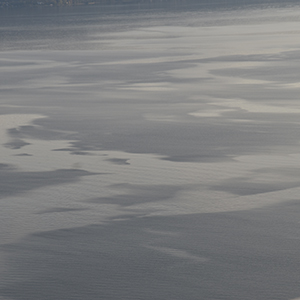Effects of natural surfactants on the spatial variability of surface water temperature under intermittent light winds on Lake Geneva

Accepted: 31 May 2022
HTML: 125
All claims expressed in this article are solely those of the authors and do not necessarily represent those of their affiliated organizations, or those of the publisher, the editors and the reviewers. Any product that may be evaluated in this article or claim that may be made by its manufacturer is not guaranteed or endorsed by the publisher.
Authors
The spatial variability of lake surface water temperature (LSWT) between smooth and rough surface areas and its potential association with the natural surfactant distribution in the surface microlayer were investigated for the first time in a lake. In spring 2019, two different field campaigns were carried out in Lake Geneva to measure: i) the enrichment factor of fluorescent dissolved organic matter (FDOM) as a proxy for biogenic surfactants, and ii) LSWT and near-surface water temperature profiles while simultaneously monitoring water surface roughness in both cases. Results indicate that, under intense incoming short-wave radiation and intermittent light wind conditions, the atmospheric boundary layer (ABL) was stable and the accumulation of heat due to short-wave radiation in near-surface waters was greater than heat losses by surface cooling, thus creating a diurnal warm layer with strong thermal stratification in the water near-surface layer. A threshold wind speed of 1.5 m s-1 was determined as a transition between different dynamic regimes. For winds just above 1.5 m s-1, the lake surface became patchy, and smooth surface areas (slicks) were more enriched with FDOM than rough areas (non-slick) covered with gravity-capillary waves (GCW). Sharp thermal boundaries appeared between smooth and rough areas. LSWT in smooth slicks was found to be more than 1.5°C warmer than in rough non-slick areas, which differs from previous observations in oceans that reported a slight temperature reduction inside slicks. Upon the formation of GCW in non-slick areas, the near-surface stratification was destroyed and the surface temperature was reduced. Furthermore, winds above 1.5 m s-1 continuously fragmented slicks causing a rapid spatial redistribution of LSWT patterns mainly aligned with the wind. For wind speeds below 1.5 m s‑1 the surface was smooth, no well-developed GCW were observed, LSWT differences were small, and strong near-surface stratification was established. These results contribute to the understanding and the quantification of air-water exchange processes, which are presently lacking for stable Atmospheric Boundary Layer conditions in lakes.
Edited by
Marco Toffolon, Department of Civil, Environmentaland Mechanical Engineering, University of Trento, ItalyHow to Cite

This work is licensed under a Creative Commons Attribution-NonCommercial 4.0 International License.
Similar Articles
- Anna M. DESELLAS, Andrew M. PATERSON, Jon N. SWEETMAN, John P. SMOL, Assessing the effects of multiple environmental stressors on zooplankton assemblages in Boreal Shield lakes since pre-industrial times , Journal of Limnology: Vol. 70 No. 1 (2011)
- Roberto BERTONI, Cristiana CALLIERI, Esteban BALSEIRO, Beatriz MODENUTTI, Susceptibility of bacterioplankton to nutrient enrichment of oligotrophic and ultraoligotrophic lake waters , Journal of Limnology: Vol. 67 No. 2 (2008)
- Jesper GULDBERG HANSEN, The deep sea elements of the Faroe Bank tardigrade fauna with a description of two new species , Journal of Limnology: Vol. 66 No. s1 (2007): 10th International Symposium on Tardigrada
- Brigitte LODS-CROZET, Olivier REYMOND, Bathymetric expansion of an invasive gammarid (Dikerogammarus villosus, Crustacea, Amphipoda) in Lake Léman , Journal of Limnology: Vol. 65 No. 2 (2006)
- Valeria ROSSI, Carlo BELLAVERE, Giorgio BENASSI, Andrea GANDOLFI, Eletta B.A. TODESCHI, Paolo MENOZZI, Spatial segregation of Darwinula stevensoni (Crustacea: Ostracoda) genotypes in lentic and lotic habitats of Northern Italy , Journal of Limnology: Vol. 63 No. 1 (2004)
- Irina CHUBARENKO, Boris CHUBARENKO, Erich BÄUERLE, Yongqi WANG, Kolumban HUTTER, Autumn physical limnological experimental campaign in the Island Mainau littoral zone of Lake Constance , Journal of Limnology: Vol. 62 No. 1 (2003)
- Cristiana CALLIERI, John G. STOCKNER, Freshwater autotrophic picoplankton: a review , Journal of Limnology: Vol. 61 No. 1 (2002)
- Rocco TIBERTI, Morphology and ecology of Daphnia middendorffiana, Fisher 1851 (Crustacea, Daphniidae) from four new populations in the Alps , Journal of Limnology: Vol. 70 No. 2 (2011)
- Fabrizio STEFANI, Barbara LEONI, Alessandro MARIENI, Letizia GARIBALDI, A new record of Craspedacusta sowerbii, Lankester 1880 (Cnidaria, Limnomedusae) in Northern Italy , Journal of Limnology: Vol. 69 No. 1 (2010)
- Daniel Nyqvist, Matiss Zagars, Olle Calles, Claudio Comoglio, Behavior of trap-and-transported Atlantic salmon spawners of hatchery origin in the Daugava River system (Latvia) , Journal of Limnology: Vol. 78 No. 2 (2019)
<< < 78 79 80 81 82 83 84 85 86 87 > >>
You may also start an advanced similarity search for this article.
-
Seyed Mahmood Hamze-Ziabari, Mehrshad Foroughan, Ulrich Lemmin, David Andrew BarryRemote Sensing : 2022
-
Mehrshad Foroughan, Seyed Mahmood Hamze‐Ziabari, Ulrich Lemmin, David Andrew BarryGeophysical Research Letters : 2022

 https://doi.org/10.4081/jlimnol.2022.2048
https://doi.org/10.4081/jlimnol.2022.2048





